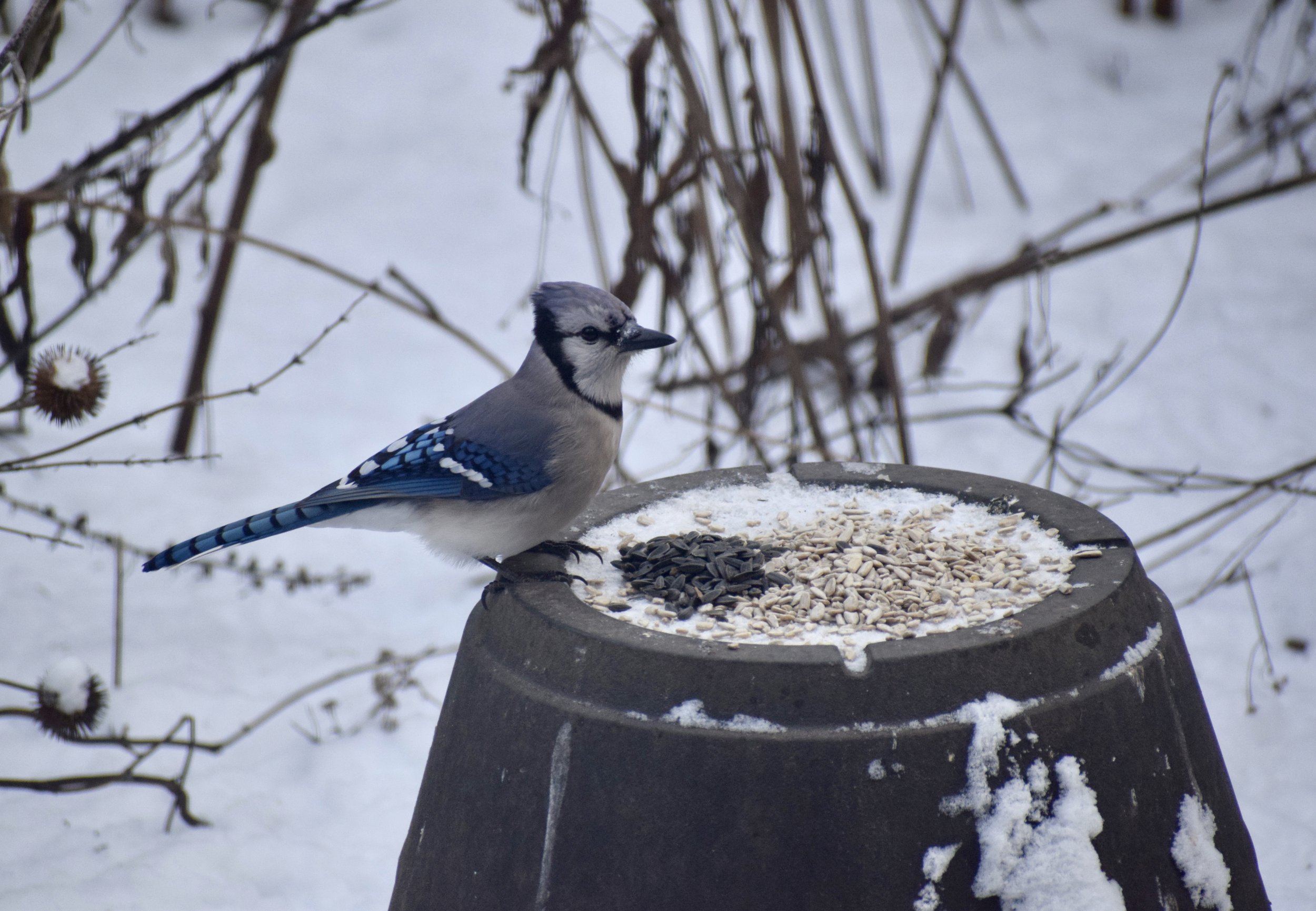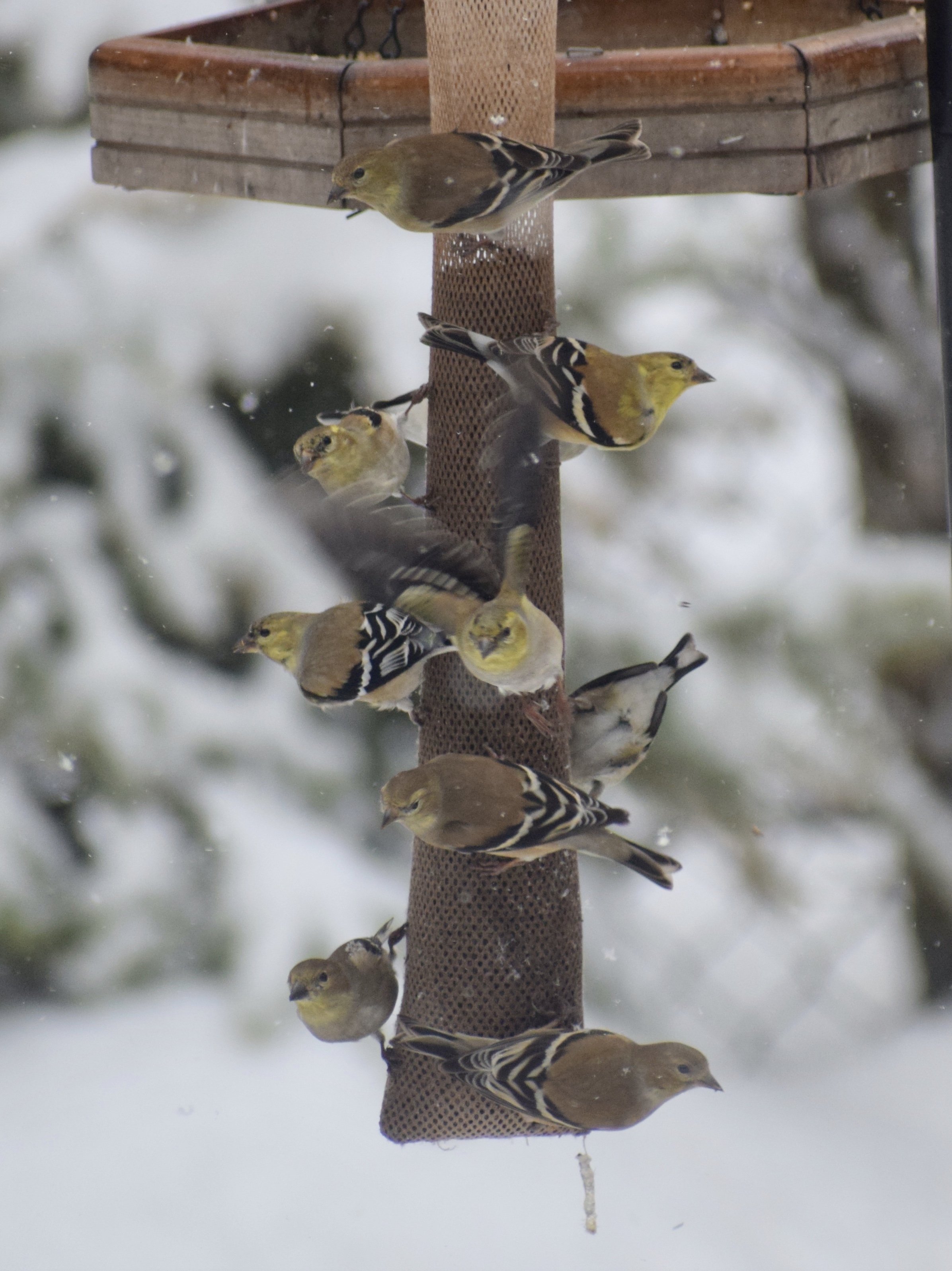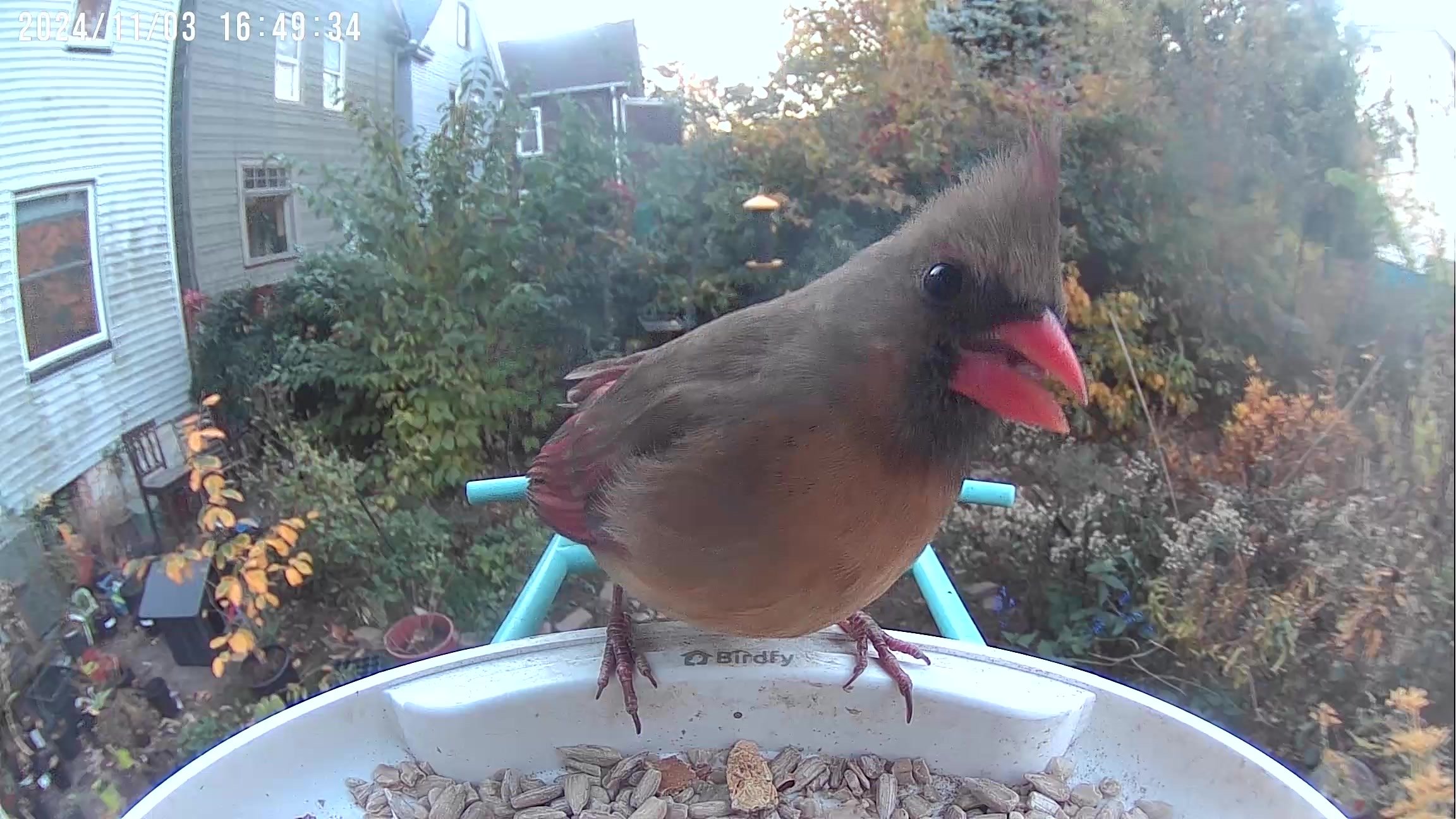Food, glorious food
This morning it was 11 degrees Fahrenheit at 9.30 am with a “feels like” temperature of -1. The snow that was soft and fluffy yesterday is icy and unforgiving today. My gloves kept sticking to the bird feeders as I refilled them and de-iced the birdbaths. It’s that cold.
A blue jay this morning, getting stuck in to some black oil sunflower seeds.
And still the birds have to eat, and drink, and clean themselves. The house sparrows, starlings, and mourning doves descend to feed as soon as I put the food out, even if I’m just a couple of feet away. The blue jays, house finches, grackles, red-winged blackbirds, the white-breasted nuthatch (can’t tell if it’s one or several), tufted titmice, dark-eyed juncos, the solitary red-bellied woodpecker—they wait till I’m back inside. But as soon as it’s safe, the birds quickly descend.
I go through a lot of bird food at this time of year. And since the question of what best to feed backyard birds, and how to attract more birds/discourage unwanted ones is something that comes up frequently, I figure this is a good topic for a first post. All opinions are my own, your backyard may vary, etc.
There’s a daunting array of bird food out there, and it’s not cheap, so it’s tempting to go for big bags of blends that seem to offer the most for the money. Unfortunately, cheap food blends often contain a lot of filler seeds to bulk out the volume, seeds that most song birds in this region don’t eat, and that will either go to waste and make a mess in your yard or get eaten by squirrels (or other creatures). They may also contain ingredients that birds just don’t need, such as artificial coloring and flavoring.
I buy single varieties for the most part—black oil sunflower, safflower, nyjer, peanut pieces, whole peanuts, shelled sunflower bits, and various types of suet. Different birds prefer different seeds, and may use different feeders and feeding methods. Some birds are mostly ground feeders (native sparrows, dark-eyed juncos); others like hopper feeders, where they can fly in, grab food, and usually fly off to eat it or stash it elsewhere (tufted titmice, chickadees, cardinals). Finches (American goldfinches and house finches) love nyjer, which is a tiny seed that requires a nyjer feeder or finch sock. Woodpeckers like specialized feeders for suet or nuts.
American goldfinches on a nyjer finch sock a couple winters ago.
If you’re going to buy just one type of bird food, go for black oil sunflower seed. It’s higher in fat than many other seeds (and birds need that right now), and eaten by the widest variety of backyard birds. Bonus: it’s available at most supermarkets and not too pricey. Downside is that birds discard the shell before eating it, and that can get messy. Try using a ground tray for feeding rather than just sprinkling seed around. You can also get a tray to attach to a feeder pole that will catch shells from feeders above.
Buying shell-less sunflower seed pieces, sometimes labeled as sunflower hearts or kernels, solves the waste problem, but gets a little pricier.
My second recommendation is safflower seed, not so much for the birds that eat it (finches, cardinals, nuthatches, mourning doves, and more) as for the ones that don’t. House sparrows are not fans of safflower, as the shell is too hard for them to get through, and most of the “bully birds,” such as starlings and grackles, also avoid it. As do squirrels. So, if you’re getting inundated with birds you don’t want, try safflower. Downside: like black oil sunflower, safflower has a shell that gets discarded. There’s now a new variety, golden safflower, which claims to have a thinner hull and more nutritional content than regular safflower. I use the regular ol’ white safflower and put up with the shells.
Tufted titmouse with a safflower seed.
Close third recommendation is peanuts, either pieces or whole. Either way, they must be unsalted. (Some sources claim that raw peanuts are dangerous to birds because of potential disease from moldy peanuts, others say no. I generally feed raw.) In any case, you can buy whole peanuts in the shell, and many birds love them. Blue jays especially, also woodpeckers and tufted titmice, who look especially adorable when flying off with a peanut the width of their head.
Peanut pieces are popular with just about every bird who’ll visit your yard. And there’s no discarded shells and no waste (especially if you have squirrels around). High in fat and protein, they’re a great winter food.
Red-bellied woodpecker, a big fan of suet and peanuts.
Another great option for cold weather is suet. Suet cakes, suet balls, suet pieces, suet nuggets, spreadable suet…it’s all high-energy, tasty stuff that can sustain birds through very cold weather. Downy woodpeckers and red-bellied woodpeckers love suet. Unfortunately, so do lots of other birds who may crowd your feeders. Good-quality suet products can be expensive and you want it to go where it counts. Not easy. There are ‘upside-down’ woodpecker feeders designed to deter birds that can’t cling, but starlings and sparrows are wily little devils and they’ll keep trying.
Wiliest of all are squirrels, and even with baffles on the feeder poles, I end up feeding a lot of squirrels. There are bird foods with added hot pepper meant to deter squirrels. Sometimes I resort to this (and feel guilty if I see a squirrel running to the birdbath to try and wash off the sting), but mostly I let things be and pay the squirrel tax. For one thing, squirrels act as a handy alarm system, helping to alert birds if there are cats nearby. And also, you know, they’re pretty cute, and they have to deal with being a favored menu item for red-tailed hawks. No one has it easy out there, not even squirrels.
On that note, we’ll get into bird feeder placement another time, and how to help your backyard birds stay healthy and safe from predators. And also, the importance of water. And how to attract birds like Baltimore orioles and Ruby-throated hummingbirds. And…ooh. Lots more.
Questions or comments? Email me at Jerseycitybirds@gmail.com. Till next time.
Where’s lunch?





